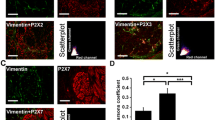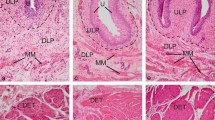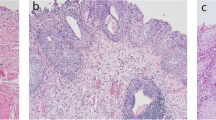Abstract
Steroid hormones such as progesterone are known to influence bladder function. Progesterone effects are mediated by the progesterone receptor (PR) but no detailed studies of PR in bladder exist. We have investigated the presence, topography and subtypes of PR in mouse, rat and human bladder. Fresh tissue samples were obtained from cystectomies in female humans, rats and mice (n = 7 per group). Tissue samples were processed for immunohistochemistry (IHC), immunofluorescence (IF) and western blot (WB) and, for each species, a panel of specific PR antibody clones was used. Interpretation of IHC/IF was carried out by light/fluorescent microscopy and of WB via standard WB software. IHC/IF in female human bladder showed PR on the interstitial cells in the lamina propria and between detrusor smooth muscle cells, whereas in female rat and mouse bladder, PR was only found on the urothelium. WB in human bladder showed a 78-kD and a 60-kDa band, respectively, corresponding to a modified PR isoform A and PR isoform C. WB in rat and mice bladder showed a 60 kDa band and a 37 kDa band, respectively corresponding with PR isoform C and an unknown isoform. This is the first detailed investigation of the precise location and presence of several isoforms of PR in bladder, together with a comparison of these data between human, rat and mouse. Our study has revealed complex PR families in bladders from the various species studied and demonstrates obvious inter-species differences in PR topography and isoforms.










Similar content being viewed by others
References
Bellance C, Khan JA, Meduri G, Guiochon-Mantel A, Lombès M, Loosfelt H (2013) Progesterone receptor isoforms PRA and PRB differentially contribute to breast cancer cell migration through interaction with focal adhesion kinase complexes. Mol Biol Cell 24:1363–1374. doi:10.1091/mbc.E12-11-0807
Blakeman PJ, Hilton P, Bulmer JN (2000) Oestrogen and progesterone receptor expression in the female lower urinary tract, with reference to oestrogen status. BJU Int 86:32–38
Cheng C-L, Groat WC de (2011) Effect of ovariectomy on external urethral sphincter activity in anesthetized female rats. J Urol 186:334–340. doi:10.1016/j.juro.2011.03.035
Cork DMW, Lennard TWJ, Tyson-Capper AJ (2008) Alternative splicing and the progesterone receptor in breast cancer. Breast Cancer Res BCR 10:207. doi:10.1186/bcr2097
Dai Q, Shah AA, Garde RV, Yonish BA, Zhang L, Medvitz NA, Miller SE, Hansen EL, Dunn CN, Price TM (2013) A truncated progesterone receptor (PR-M) localizes to the mitochondrion and controls cellular respiration. Mol Endocrinol 27:741–753. doi:10.1210/me.2012-1292
Fernandes VS, Ribeiro ASF, Martínez-Sáenz A, Blaha I, Serrano-Margüello D, Recio P, Martínez AC, Bustamante S, Vázquez-Alba D, Carballido J, García-Sacristán A, Hernández M (2014) Underlying mechanisms involved in progesterone-induced relaxation to the pig bladder neck. Eur J Pharmacol 723:246–252. doi:10.1016/j.ejphar.2013.11.025
Gevaert T, De Vos R, Everaerts W, Libbrecht L, Van Der Aa F, Oord J van den, Roskams T, De Ridder D (2011) Characterization of upper lamina propria interstitial cells in bladders from patients with neurogenic detrusor overactivity and bladder pain syndrome. J Cell Mol Med 15:2586–2593. doi:10.1111/j.1582-4934.2011.01262.x
Gevaert T, De Vos R, Van Der Aa F, Joniau S, van den Oord J, Roskams T, De Ridder D (2012) Identification of telocytes in the upper lamina propria of the human urinary tract. J Cell Mol Med 16:2085–2093. doi:10.1111/j.1582-4934.2011.01504.x
Iosif CS, Bekassy Z (1984) Prevalence of genito-urinary symptoms in the late menopause. Acta Obstet Gynecol Scand 63:257–260
Jacobsen BM, Horwitz KB (2012) Progesterone receptors, their isoforms and progesterone regulated transcription. Mol Cell Endocrinol 357:18–29. doi:10.1016/j.mce.2011.09.016
Kaore SN, Langade DK, Yadav VK, Sharma P, Thawani VR, Sharma R (2012) Novel actions of progesterone: what we know today and what will be the scenario in the future? J Pharm Pharmacol 64:1040–1062. doi:10.1111/j.2042-7158.2012.01464.x
Kowalik MK, Rekawiecki R, Kotwica J (2013) The putative roles of nuclear and membrane-bound progesterone receptors in the female reproductive tract. Reprod Biol 13:279–289. doi:10.1016/j.repbio.2013.09.001
Lu NZ, Wardell SE, Burnstein KL, Defranco D, Fuller PJ, Giguere V, Hochberg RB, McKay L, Renoir JM, Weigel NL, Wilson EM, McDonnell DP, Cidlowski JA (2006) International Union of Pharmacology. LXV. The pharmacology and classification of the nuclear receptor superfamily: glucocorticoid, mineralocorticoid, progesterone, and androgen receptors. Pharmacol Rev 58:782–797. doi:10.1124/pr.58.4.9
Luetjens CM, Didolkar A, Kliesch S, Paulus W, Jeibmann A, Böcker W, Nieschlag E, Simoni M (2006) Tissue expression of the nuclear progesterone receptor in male non-human primates and men. J Endocrinol 189:529–539. doi:10.1677/joe.1.06348
Mesiano S, Welsh TN (2007) Steroid hormone control of myometrial contractility and parturition. Semin Cell Dev Biol 18:321–331. doi:10.1016/j.semcdb.2007.05.003
Mobbs BG, Liu Y (1990) Immunohistochemical localization of progesterone receptor in benign and malignant human prostate. Prostate 16:245–251
Nelken RS, Ozel BZ, Leegant AR, Felix JC, Mishell DR Jr (2011) Randomized trial of estradiol vaginal ring versus oral oxybutynin for the treatment of overactive bladder. Menopause 18:962–966. doi:10.1097/gme.0b013e3182104977
Ogle TF, Dai D, George P, Mahesh VB (1997) Stromal cell progesterone and estrogen receptors during proliferation and regression of the decidua basalis in the pregnant rat. Biol Reprod 57:495–506
Patra PB, Thorneloe KS, Laping NJ (2009) Effect of estrogen and progesterone on urodynamics in the conscious rat. Urology 74:463–466. doi:10.1016/j.urology.2008.12.046
Robinson D, Cardozo L (2011) Estrogens and the lower urinary tract. Neurourol Urodyn 30:754–757. doi:10.1002/nau.21106
Robinson D, Cardozo L, Milsom I, Pons ME, Kirby M, Koelbl H, Vierhout M (2014) Oestrogens and overactive bladder. Neurourol Urodyn 33:1086–1091. doi:10.1002/nau.22464
Sahlin L, Masironi B, Akerberg S, Eriksson H (2006) Tissue- and hormone-dependent progesterone receptor distribution in the rat uterus. Reprod Biol Endocrinol 4:47. doi:10.1186/1477-7827-4-47
Samalecos A, Gellersen B (2008) Systematic expression analysis and antibody screening do not support the existence of naturally occurring progesterone receptor (PR)-C, PR-M, or other truncated PR isoforms. Endocrinology 149:5872–5887. doi:10.1210/en.2008-0602
Savolainen S, Santti R, Streng T, Gustafsson JA, Härkönen P, Mäkelä S (2005) Sex specific expression of progesterone receptor in mouse lower urinary tract. Mol Cell Endocrinol 230:17–21. doi:10.1016/j.mce.2004.11.008
Schneider W, Ramachandran C, Satyaswaroop PG, Shyamala G (1991) Murine progesterone receptor exists predominantly as the 83-kilodalton “A” form. J Steroid Biochem Mol Biol 38:285–291
Shao R, Markström E, Friberg PA, Johansson M, Billig H (2003) Expression of progesterone receptor (PR) A and B isoforms in mouse granulosa cells: stage-dependent PR-mediated regulation of apoptosis and cell proliferation. Biol Reprod 68:914–921
Taylor AH, McParland PC, Taylor DJ, Bell SC (2009) The cytoplasmic 60 kDa progesterone receptor isoform predominates in the human amniochorion and placenta at term. Reprod Biol Endocrinol 7:22. doi:10.1186/1477-7827-7-22
Teilmann SC, Clement CA, Thorup J, Byskov AG, Christensen ST (2006) Expression and localization of the progesterone receptor in mouse and human reproductive organs. J Endocrinol 191:525–535. doi:10.1677/joe.1.06565
Tincello DG, Taylor AH, Spurling SM, Bell SC (2009) Receptor isoforms that mediate estrogen and progestagen action in the female lower urinary tract. J Urol 181:1474–1482. doi:10.1016/j.juro.2008.10.104
Wen DX, Xu YF, Mais DE, Goldman ME, McDonnell DP (1994) The A and B isoforms of the human progesterone receptor operate through distinct signaling pathways within target cells. Mol Cell Biol 14:8356–8364
Xiao Z-L, Cao W, Biancani P, Behar J (2006) Nongenomic effects of progesterone on the contraction of muscle cells from the guinea pig colon. Am J Physiol Gastrointest Liver Physiol 290:G1008–G1015. doi:10.1152/ajpgi.00382.2005
Yeates C, Hunt SM, Balleine RL, Clarke CL (1998) Characterization of a truncated progesterone receptor protein in breast tumors. J Clin Endocrinol Metab 83:460–467. doi:10.1210/jcem.83.2.4531
Yu Y, Liu L, Xie N, Xue H, Fazli L, Buttyan R, Wang Y, Gleave M, Dong X (2013) Expression and function of the progesterone receptor in human prostate stroma provide novel insights to cell proliferation control. J Clin Endocrinol Metab 98:2887–2896. doi:10.1210/jc.2012-4000
Yu Y, Lee JS, Xie N, Li E, Hurtado-Coll A, Fazli L, Cox M, Plymate S, Gleave M, Dong X (2014) Prostate stromal cells express the progesterone receptor to control cancer cell mobility. PLoS One 9:e92714. doi:10.1371/journal.pone.0092714
Acknowledgments
We are grateful to Paula Aertsen, Gijs Budé, Nathalie Volders, Kathleen Van Den Eynde and Emily Bittoun for excellent technical support. Prof. Pieter Vandenberghe is acknowledged for the use of the confocal microscopy facility.
Author information
Authors and Affiliations
Corresponding author
Ethics declarations
Conflict of interest
The authors confirm no conflicts of interest.
Author input
T.G., T.V. and D.D.R. designed the research study; T.G. and R.R. performed the research; T.G., R.R. and W.E. analyzed the data; T.G., W.E. and D.D.R. wrote the manuscript.
Additional information
This study was supported by Research Foundation Flanders (FWO) Grant G.0500.6N and Research Council of the KU Leuven Grants PF-TRPLe and EF/95/010, Belgian Federal Government Grant IUAP P7/13 and an unrestricted educational grant from Astellas. Dirk De Ridder is a senior clinical researcher of the FWO Vlaanderen.
Electronic supplementary material
Below is the link to the electronic supplementary material.
Suppl. Table 1
Properties of the antibodies used. (DOCX 19 kb)
Suppl Figure 1
Image of a loading control experiment with beta-actin on three human samples (H1 full fraction, H1’ cytoplasmic fraction). (GIF 7 kb)
Suppl Figure 2
Top Confocal double-immunofluorescence images showing non-specific immunofluorescent activity on red blood cells (white arrows). Bottom Confocal double-immunofluorescence images showing diffuse nuclear PR expression on BrCa with interlaying Vim+ stromal cells (BL bladder, BrCa breast cancer, V blood vessel). Bars 50 μm (top), 100 μm (bottom). (GIF 106 kb)
Suppl Figure 3
Images of control IHC. a PR- BrCa (human, clone PGR636). b, c Monoclonal anti-smooth muscle actin antibody was used at 1/50 dilution and revealed immunoreactivity on ULP IC, perivascular smooth muscle and detrusor smooth muscle (U urothelium, LP lamina propria, D detrusor). No immunoreactivity was seen on the urothelium (white arrows). Bars 50 μm (GIF 111 kb)
Suppl Figure 4
IHC and WB for PR with A0098 clone in female human bladder. a Weak nuclear PR expression (white arrows) on ULP IC (U urothelium, LP lamina propria). b PR expression on BrCa (positive control). Bars 50 μm. c WB analysis of PR isoforms in female human bladder tissue. BrCa positive (+) and negative (−) for PR receptor was used as a positive and negative control, respectively. Positions of isoforms are indicated (PRB, PRA, PRC). Exposure time was 1200 s (BL bladder, + positive control, – negative control). (GIF 99kb)
Rights and permissions
About this article
Cite this article
Gevaert, T., Rietjens, R., Voets, T. et al. Topographies and isoforms of the progesterone receptor in female human, rat and mouse bladder. Cell Tissue Res 364, 385–394 (2016). https://doi.org/10.1007/s00441-015-2329-y
Received:
Accepted:
Published:
Issue Date:
DOI: https://doi.org/10.1007/s00441-015-2329-y




